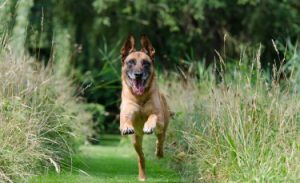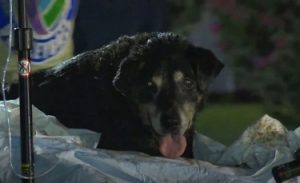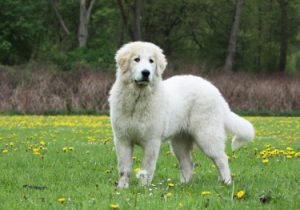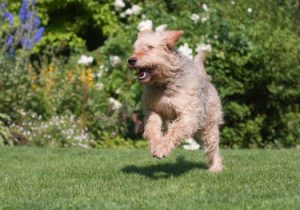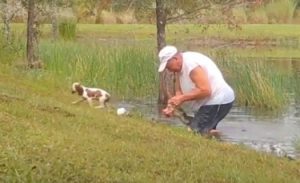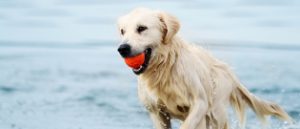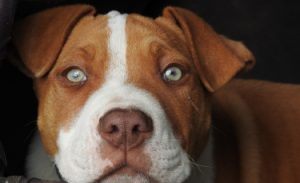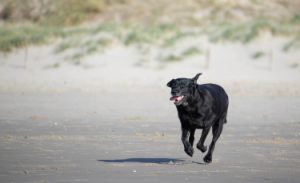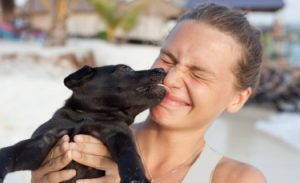Other names: Newfoundland dog, Newfoundland, Newfie
The Newfoundland under its gentle and calm gait hides treasures of courage and an impressive capacity for work. Exceptionally strong, he is active and hardworking, but not restless when he has nothing to do. It has the characteristic of having webbed feet which allow it to be an outstanding swimmer. The Newfoundland is a dog that perfectly meets the expectations of a family. He is overflowing with love, he is gentle, calm, shows unfailing generosity, does not bark much. He is protective, loyal and faithful. He is never aggressive and would give his life for that of his master. He is in very good health, is not very difficult to educate and is not difficult on a daily basis.
<!–
–>
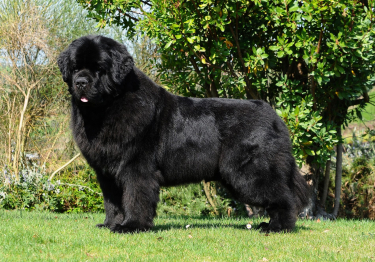
| Half-long | |
| Canada | |
| Giant | |
| Square |
| Sex | Weight | Cut |
|---|---|---|
| Female | From 50 kg to 60 kg | From 66 cm to 69 cm |
| Male | From 60 kg to 70 kg | From 68 cm to 71 cm |
History of the breed
Newfoundland owes its name to the island Newfoundland in Canada , but its origin is rather unclear . Born on the American continent, it would be a crossbreed between indigenous dogs and the great black bear dog introduced by the Vikings in the 12th century.
The arrival of European fishermen and in particular the English cod fishermen in the 16th century, which brought him some specimens on their boats, have helped shape the breed. It was first used by fishermen to whom he brought back the heavy nets of fish. He was then used as a draft dog, shepherd, hunting or guard, and was even postman in 1880 on his island of origin. He is now a companion and aquatic rescue dog.
The first breed standard was established in 1923 and the current one, dating from 1996, is under Canadian responsibility.
Newfoundland Pictures
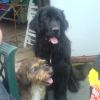
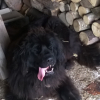
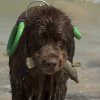
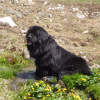
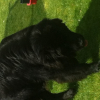
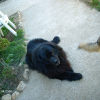
View all Newfoundland photos from Woopets members
Physical features
His hair : double with a mid-length cover. It is thick, oily, and flat. The undercoat is dense. The whole forms a cold-resistant and waterproof barrier. On the head, the hair is short and fine.
Its color : 3 colors are allowed according to the standards (French, American or Canadian). The black and the brown which can be chocolate or bronze. The third color is the two-tone white and black.
Its head : is broad and massive. It has a fairly rounded top. The muzzle is short and neatly cut, quite square in shape.
His ears : small and triangular. They are set at a right angle, well behind the crown of the head. They descend to the sides of the skull.
His eyes : dark brown in color and small. They are rather apart from each other, but well embedded.
His body : solid with ribs well out, a broad back and strong and muscular loins. The chest is deep and wide.
Its tail : is of medium length, strong and broad at the base. At rest, it hangs down and curls slightly at its end. When the Newfoundland is active she gets up and when excited she sits horizontal with a slight curvature at the tip.
Behavior and character
| Affectionate | |
|---|---|
| Calm | |
| Protective | |
| Independent | |
| Hunter | |
| Barks / howls |
Behavior with others
| Cohabitation with children | |
|---|---|
| Sociable with other animals | |
| Love strangers |
The main qualities of the Newfoundland are courage and great capacity for work . He is a dog with tremendous strength . It is not for nothing that it is often used as a rescue dog. He is still active with impressive stamina . He also has webbed feet , which is advantageous in the water when swimming. It is a canine of great gentleness , very loyal and loyal .
He is dignified and particularly docile . He is unfazed, calm and always shows a good mood . He is naturally happy . He knows how to understand his master, from whom he cannot be separated. He doesn’t like loneliness. He greatly appreciates the company of children, whom he will supervise and with whom he will play. Its imposing stature impresses and can dissuade. However, he is never aggressive , even with strangers whom he will simply be wary of. He is also at ease with fellow creatures.
Newfoundland
is it right for you? Take the test!
Education
| Clever | |
|---|---|
| Obedient |
Newfoundland, because of its size, requires serious education . He has a strong personality and exceptional sensitivity . We must therefore not confuse training and education at the risk of blocking it. It doesn’t lend itself to good-hearted obedience exercises, so it’s a matter of staying very positive . His fiery youth implies instilling in him rules of decorum very quickly. His intelligence and his desire to please his master are important assets that should be taken advantage of.
Living conditions
| Suitable for apartment living | |
|---|---|
| Good for new masters | |
| Love it hot | |
| Love the cold |
The ideal for him is a house with a park and a pond . That said, he adapts to everything, even in an apartment, because he knows how to stay quiet. Of course, in this case, it will have to be taken out very regularly, otherwise it will be very unhappy. The well educated Newfoundland is very kind to children and other animals. He can therefore live with his family to the delight of everyone. He must be able to run when he wants to, because he needs to exercise. Between each outing, he must be present with his master.
Health
| Solid | |
|---|---|
| Ease of gaining weight |
Newfoundland is in particularly strong health . He only knows one disease typical of large dogs: hip and elbow dysplasia . Thus, it is advisable to moderate his efforts and his physical activity in the first years of his life. Because of his double blanket, he is quite sensitive to heatstroke . In summer, it would be wise not to expose it to the sun for too long. In addition, because of his numerous dives in water, it is necessary to monitor his ear canals , frequently affected by ear infections or infection of this kind. Regular cleaning helps prevent them.
Hypoallergenic breed
No
Litter size
Between 4 and 12 puppies
| Major concerns |
|
|||||
| Minor concerns |
|
| Occasional concerns |
|
||||
| Suggested tests |
|
To protect you from these risks and insure your companion in the event of health problems, Woopets recommends Newfoundland dog insurance .

function showAssuranceForm () {var siteReferer = var id_race_association = ‘272’; //console.log(id_race_association);success: function (html) {}});}document.addEventListener (‘DOMContentLoaded’, () => {$ (‘# assuranceModalBanner’). on (‘show.bs.modal’, function (event) {showAssuranceForm ();});});
Life expectancy
Minimum: 8 years
Maximum: 10 years
The life expectancy of a Newfoundland is, on average, between 8 years and 10 years.
Calculate the human age of your Newfoundland!
To choose… 1 year 2 years 3 years Four years 5 years 6 years 7 years 8 years 9 years 10 years 11 years old 12 years 13 years 14 years old 15 years old 16 years old 17 years 18 years old 19 years old 20 years 21 years old
Maintenance and hygiene
| Ease of maintenance | |
|---|---|
| Cost of maintenance | |
| Hair loss |
| Drool level | |
|---|---|
| Ease of grooming |
The Newfoundland moults twice a year , in the spring and in the fall. During this period, you can use a straight-tipped weeder. If the dog lives outdoors, the spring molt is impressive.
As its fur tends to tangle easily, the Newfoundland requires brushing at least twice a week . It may be necessary to trim the excess hair in the ears for his well-being. After each swim in the sea, it should be rinsed properly. To keep the waterproof qualities of its coat intact, it should not be shampooed. Frequent baths are not necessary .
His eyes and ears should be checked regularly to make sure there is no trace of dirt or any infection. The ears should be cleaned with cotton soaked in an ear cleaner for dogs with a neutral pH. If he does not wear them out naturally, his nails have to be cut. If you are new to this, it is recommended that you seek advice from a veterinarian. Finally, to eliminate the build-up of tartar and the proliferation of bacteria, his teeth should be brushed on a regular basis.
Price and budget
Purchase price
Mini
€ 1,100 Maxi
1600 €
The purchase price of a Newfoundland is between € 1,100 and € 1,600.
Annual maintenance cost
Mini
€ 1,800 Maxi
2300 €
The annual maintenance cost of a Newfoundland is between € 1,800 and € 2,300.
Name ideas for a Newfoundland
| Male |
|
| Female |
|
None of these proposals suit you? Use our tool to find the name of your Newfoundland!
Food
Newfoundland must always have water available . Regarding his diet , industrial food is best suited to his size and needs. Thus, it is necessary to opt for high quality croquettes to be given in one to 2 sufficient rations according to the daily energy expenditure of the Newfoundland.
Want the best for your dog?
Create tailor-made food for your Newfoundland
I discover !
PROMO -30% | Delivered to you!

Physical activity
| Athletic | |
|---|---|
| Energy level | |
| Potential to play |
The Newfoundland is a bon vivant who loves the great outdoors and needs to exercise daily. Above all, he loves to swim . Swimming will allow him to work his muscles. A master who can offer him walks along rivers , ponds or the sea will make him happy. Happy, he will also enjoy sharing a few outdoor play sessions with his owner.
His physical skills and intelligence make him excel in certain dog sports, such as agility or tracking.
Famous Newfoundland dogs
Bilbo : This is the name of England’s most famous coastguard. The Newfoundland is owned by Steve Jamieson , a British lifeguard. The animal is known for its incredible swimming qualities and its natural propensity to ensure the safety of bathers. Since 2006, he has saved 3 people from drowning. It also deters swimmers from venturing too far or into rough waters.
Seaman : This is Captain Meriwether Lewis’ Newfoundland. The dog took part in the famous Lewis and Clark expedition . Known to be very intelligent and loyal, he also helped team members capture animals.
Competitions
| Classifications & Standards |
|
Others
| Master character <span class="btnTooltip qTip2" title="- Calm: the master must be gentle and know how to show patience. – Active: the owner must be energetic and dynamic to live in harmony with his dog. – Hyperactive: the owner must be stimulating and very restless to suit the temperament of his dog.”> |
Active |
|---|
We talk on the forum
Newfoundland
Message from pouguy
Bernese Mountain Dog, Newfoundland … in the tropics
Guest message
What condition to have to have a new earth
Message from Jack Potio
Why is my dog rubbing his muzzle on the ground?
Guest message
My dog loves potatoes
Guest message
Have a question about Newfoundland?
Do not hesitate to ask Woopets visitors for advice on the forum!
FCI Information
FCI No.
50
FCI Group
Group 2: Pinscher and Schnauzer – Molossoid and Swiss Mountain and Cattle Dogs and other breeds
Recognized by FCI
Since 1954
</div


